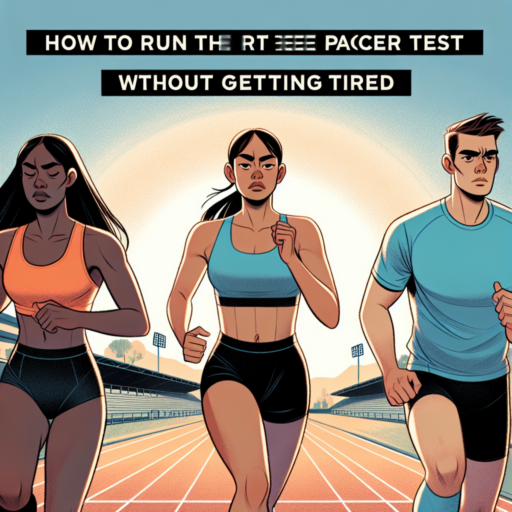How to pass the PACER test easily?
Passing the PACER (Progressive Aerobic Cardiovascular Endurance Run) test requires a blend of strategy, endurance, and preparation. This test, designed to evaluate aerobic capacity, challenges participants to run as long as possible back and forth across a 20-meter space at increasing speeds. With the right approach, you can enhance your performance and achieve higher levels without undue stress.
Develop a Consistent Training Routine
Begin your preparation by establishing a consistent training routine well ahead of the test date. Incorporate activities that build aerobic capacity and endurance, such as jogging, cycling, or swimming. Interval training, which alternates short bursts of high-intensity exercise with longer intervals of less intense recovery periods, can also mimic the PACER test’s progressive nature. Remember, consistency in your training routine is key to gradual improvement and success.
Master the Turn Technique
Efficiency in the PACER test isn’t just about speed; it’s also about minimizing energy expenditure. Mastering the turn technique at each end of the 20-meter run can significantly conserve energy and improve your score. Practice making quick and tight turns, pushing off with your outside foot to gain a burst of speed as you head in the opposite direction. By refining this technique, you can maintain a steady pace for longer periods, reducing the overall strain on your body.
Focus on Your Breathing
Proper breathing plays a crucial role in pacing and endurance in any cardiovascular test. Work on developing a rhythmic breathing pattern that syncs with your steps. This can help in maintaining a consistent pace and avoiding early fatigue. Inhale and exhale deeply through both your nose and mouth, allowing for maximum oxygen intake and carbon dioxide expulsion. Focused and controlled breathing can make a significant difference in extending your ability to keep running during the test.
How many laps should a 12 year old get on the PACER test?
The PACER test, known formally as the Progressive Aerobic Cardiovascular Endurance Run, is a multistage aerobic capacity test that progressively becomes more challenging. It gauges a child’s aerobic capacity and endurance, essential elements of physical fitness. The test involves running back and forth across a 20-meter space at an increasing speed, as dictated by audio cues. For a 12-year-old, understanding how many laps they should aim for provides a clearer goal and may help in gauging their cardiovascular health and endurance levels.
While there are general guidelines and expectations for performance in the PACER test, it’s crucial to remember that every child is unique. Their capabilities may vary greatly depending on their level of physical activity, natural endurance, and even genetic factors. That said, for a 12-year-old, achieving around 20-40 laps in the PACER test can be considered a reasonable ballpark based on age-adjusted fitness norms. It’s a broad range, acknowledging the wide spectrum of physical fitness levels among children of the same age.
Improvement over time is more indicative of aerobic fitness than any single test result. It is encouraged for children to focus more on their personal progress, attempting to increase the number of laps they can complete with each subsequent test. Engaging regularly in aerobic activities, such as running, swimming, or cycling, can help a 12-year-old improve their PACER test outcomes, bolstering both their physical health and their confidence in their athletic abilities.
How to do the beep test without getting tired?
Mastering the beep test without succumbing to fatigue involves a blend of strategic preparation and in-the-moment tactics. It’s not just about raw endurance; understanding how to effectively manage your energy can significantly boost your performance. This guide will help you navigate the challenge, ensuring that you can run longer, respond quicker, and avoid the dreaded exhaustion that comes with this rigorous fitness test.
Optimize Your Running Technique
Efficiency is key when it comes to the beep test. Improving your running technique can dramatically reduce the amount of energy expended with each step. Focus on maintaining a light, agile step and avoid overstriding. Keeping your movements compact and controlled conserves energy, allowing you to stay in the game for longer periods without feeling worn down.
Strategically Pace Yourself
Pacing is crucial in the beep test. Starting too fast can deplete your energy reserves prematurely, while too slow of a start can put you in a difficult position for catching up. The best strategy is to find a comfortable pace that aligns with the beep intervals, allowing for slight adjustments as the test progresses. This pacing technique helps in navigating the changing speeds without exhausting yourself too early on.
- Begin with a moderate pace to conserve energy
- Gradually adjust your speed in response to the beep intervals
- Anticipate the beep to minimize unnecessary sprints
No se han encontrado productos.
How to increase stamina for a beep test?
Improving your stamina for a beep test is a common goal among athletes and law enforcement candidates. This test assesses your aerobic capacity and requires both physical and mental preparation. By focusing on specific training methods, you can significantly boost your performance and achieve a higher level of physical fitness. Understanding the key strategies is crucial for anyone looking to improve their beep test score.
Interval Training
One of the most effective ways to increase your stamina for a beep test is through interval training. This type of training involves alternating periods of high-intensity exercise with periods of rest or lower-intensity exercise. It closely mimics the structure of a beep test, making it an ideal preparation method. By incorporating interval training into your fitness regime, you’ll improve your body’s ability to process oxygen efficiently, enhancing your overall endurance and performance during the test.
Progressive Overload
Another key strategy is focusing on progressive overload. This involves gradually increasing the intensity of your workouts over time. By slowly enhancing the challenge, your body is forced to adapt, resulting in improved stamina and strength. This can be achieved by incrementing the speed, duration, or volume of your training sessions, ensuring that you’re continuously pushing your limits and preventing your performance from plateauing.
Improving your stamina for a beep test also involves consistency and dedication to your training routine. Focusing on specific techniques such as interval training and progressive overload will help you see significant improvements in your beep test performance. Remember, the key to success is gradual progression and adapting your training to meet the demands of the beep test.



